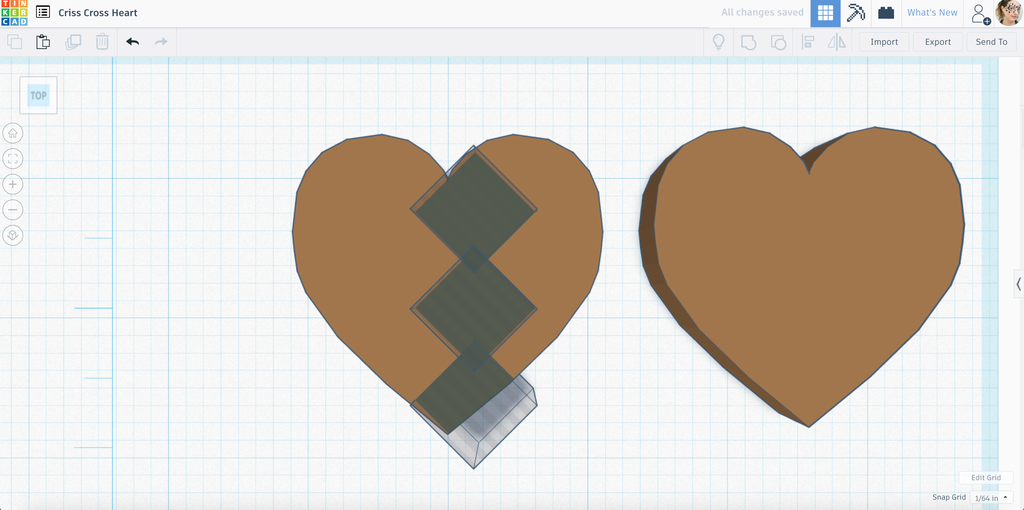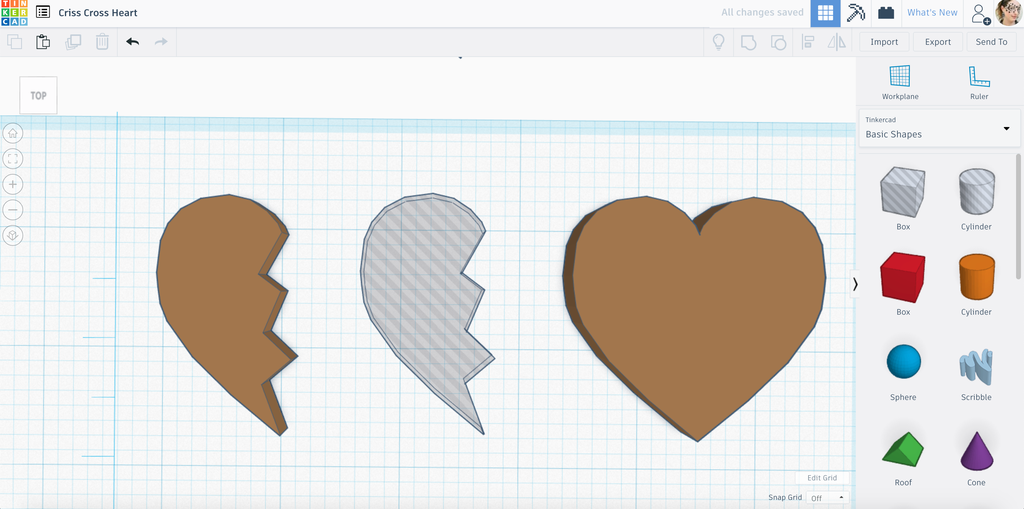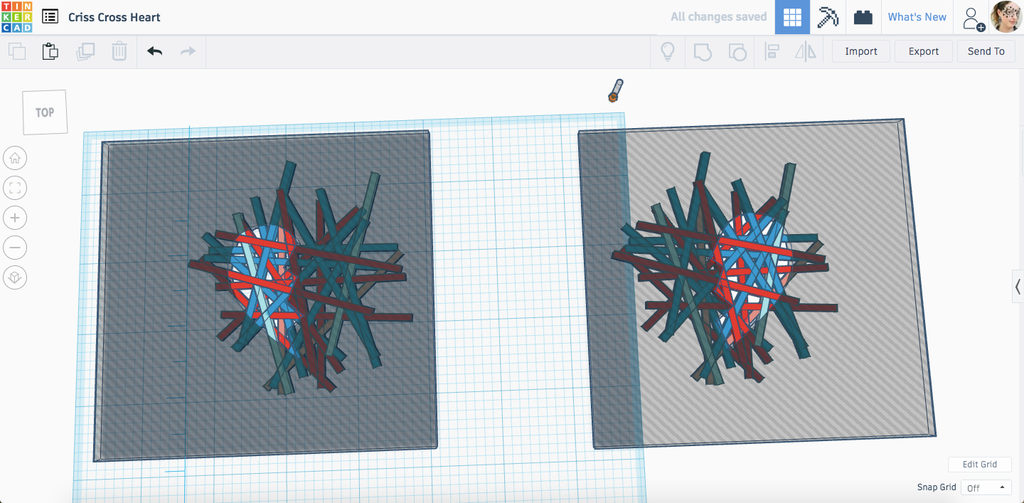Crisscross Layered Earrings - Utilizing Color Changes Between Layers in 3D Prints : 9 Steps (with Pictures) - jamesinaboust
Introduction: Crisscross Layered Earrings - Utilizing Color Changes Between Layers in 3D Prints
What started every bit a greeting card design, evolved into Christmastime earrings, and at long last became these crisscross cutout layered earrings in a variety of shapes. You can employ indefinite of the designs I've created, OR use this technique with another shape. Beryllium sure to share pictures of your designs :)
Since I don't have multiple extruders, I like to try to come up with designs that can be enhanced by color changes between layers and really kind-hearted of took that to the extreme here with 4 colourize changes. I am quite happy with the results which I have made in Diamond, Ellipse, Sum, Star, and Broken Kernel shapes.
Instructable 300

You can buy all 5 styles of these earrings in my Etsy Depot in whatever colors I have.
Footmark 1: Supplies
Supplies:
- 3D Printer - I'm exploitation a Prusa MK3
- Slicer - I'm exploitation Simplify3D but Cura should be able to do colorise changes easily too
- Filament in the colors you need. You tail end make out these in one color, but I think 2 looks best.
- Earwires
- Jewellery Pliers
Originally, these designs were going to be just 2 colors in 2 layers, and while they looked interesting during my test prints with 1 color when I tried them with 2, it was just non working. The top color just overpowered the one below and it didn't look nice. After some rethinking, I decided to do these in 5 layers split 'tween 2 colors and I'm pretty happy with the results. You can see the evolution of the design in the second image.
Step 2: Files
I'll blab about the creation of the designs in the next two steps, just you can get on the designs here.
Above you can hear each human body and how they look from front and rearward.
Tone 3: Bedded Rectangles
I made these designs using Tinkercad.
Now, to go with you need the earring shape you want in the size you want. In my example, we are doing the diamond which was 1" wide and 2" marvelous. The thickness ISN't as important right directly equally you prat change it whenever you lack.
Fill this shape and make it a hole. Also, make a largish square. It doesn't give birth to beryllium a certain size of it, righteous bombastic sufficient that information technology can cut bump off the ends of your rectangles later, but mine is 4" away 4". Pass firm.

Stoc the shapes up so the cutout is in the center field and aggroup them.

Now you have the earring shape.

Bi it into a hole.

Sentence for the rectangles.
So, this innovation evolved over time, just in the end, I ended up with an earring designing that consisted of rectangles that are the same length and width but contrasting heights. I split the rectangles up into 5 high and distinct they would be 2 different colors (depending along stratum height).
The plan was that the 1st, 3rd, and 5th layers to be one colouring and the 2nd and 4th layers to be other. Meaning, I needed the same number of rectangles split between layers 1,3,5 and 2,4.
To make sure my colour in reportage was good, I colored the layers thusly I could examine where the colors would show up and where they would be overlapped and covered.
My finish was for from each one color to be 2 layers when sliced, meaning the first color went up 2 layers, the endorse color showed up 4 layers, third was 6 layers, forth was 8 layers and fifth was 10 layers.
Layers/Rectangles: (18 total with 9 of to each one people of color) at a lower place is # of rectangles, which color, and height
- 3 - color 1 - .5 mm
- 5 - color 2 - .9 mm
- 3 - color 1 - 1.3 mm
- 4 - colorise 2 - 1.7 mm
- 3 - color 1 - 2.1 mm
This is in all likelihood puzzling, but the design changed so IT's a little difficult to explain how to choke from the icon above to the one under.
The goal was to make sure the colors were spaced considerably enough that you could see about an equal measure of each. I started with each color a different layer so I could see where everything was.

Then, I checked everything by food color the layers appropriately. So 1, 3, and 5 one color with 2 and 4 another color.
From here, I moved rectangles around until I was happy with the layout. Compensate attention to how so much of each colouring material you can interpret you bet the edges of the human body look. You want to try to avoid huge gaps that detract from the shape. For example, I tried to make sure the rectangles went out at the diamond points thus I would have that definition. Also, make sure you have some definition at the top so you'll atomic number 4 able to attach the loop.

Group the rectangles and the shape cutout. If you don't like the spirit, ungroup and preserve moving things roughly.

The cobbler's last thing to coiffure is add a loop. When I can, I prefer to add a jam into the blueprint to make IT look more natural, simply the tenuity of these lines didn't allow it. So, I added on a coil that was made from a cylinder that was 2.68mm in diameter and had a hole that was 1.50mm in diameter.
I made sure everything was centered and connected, then I grouped them.

To finish off your earrings, I recommend, copying it and mirroring it. I prefer this to two earrings the same, but it's a personal preference.

Now you take over a set of earrings. You can repeat this unconscious process for any shape you'd like.

Ill-use 4: How to Piddle a 3D Print Broken Bosom
In this step, I'm going to talk about, not only how I made the broken heart that fits together, but how I got the rectangle/lines to match up betwixt the pieces likewise.
To begin with, you need a heart that is the hight you want the earring and about double the width (since we'll be cutting information technology in half).
Bestow in some squares and make them into holes. I turned them 45 degrees and then started messing with their determine and orientation.

Below you can see how I ultimatly had the squares shaped. One matter I wanted to adjudicate to make Here was get ahead the shapes to dress with the tip of the heart on the bottom and the dip in the heart on the top to aim a unused cut away.
Aggroup these shapes together with the heart.

Once I had the cutout, I needed to get rid of the eternal rest of the heart on that side. I just pulled in a hearty and misrepresented it until it covered wholly the bits. Radical.

Forthwith I had one half of the heart. I copied IT and made the copy into a cutout.

Next, line the cutout with the left and top side of the full heart. Group together.

Nowadays there are two halves that scene together perfectly. If you don't wish the way things look here, undo and change up the path the shapes cut into the first half until you like it.

Look, they line up!

Now, do what you did in the last step with both of these halves so you have cutouts for each earring.

Line them up so they are almost perfectly lined up.

This next part got pretty messy but I had to bring up over the rectangles from one of the early earrings I did and started moving them just about. I wanted them to forgiving of line up with the cuts along the middle so I could get a best outline for both sides. Also, I wished-for to try to keep the number of rectangles even on both sides of the heart. This took quite a spot of moving things around. I wanted to make sure the rectangles stayed on their own side of the heart but also had some that went each the way across so you could see that they seamed up together.
To brand information technology easier to do this, I took the mettle cutouts and stirred them down out of the way.

Once I was through with, I had to bring the cutout back upbound to 0. 
To get the come apart sides/hearts, I derived everything and sick it out of the way. Then, I deleted one side on each. So for the left, I deleted the right heart, for the right incline I deleted the left heart.

Below you can see the independent hearts. Group these.
Brand sure nothing is hanging out happening this personal. All parts need to beryllium connected. At this point, meet if you ilk how the individual heart sides attend. If non, you necessitate to undo until you are rearwards to having one set of everything and move the rectangles roughly until you are happy.

Directly that I had the Black Maria, it was time to add the loops as I did in the last step. I originally tried to line everything up in the midst, but then I moved things if I had to to make a point the loop topology attached to the heart. For the pith on the right, I had to move the loop over a trifle so it stayed connected.

Two esthetical pieces of a broken heart.

Time to slice!
Step 5: Slicer
I'm victimisation Simplify3D but Cura is free and has a good deal of things you can line up and should work Eastern Samoa well.
The distinguished things to keep down in judgement are:
- 100% infill
- 1 Outline
- 35% Outline Overlap
- Color Changes before layers 3, 5, 7, and 9. If you are adding in unneeded script, it will look like this:
- {Put back "; layer 3, Z =" "M600\n; Color Change, Z ="}
- {REPLACE "; level 5, Z =" "M600\n; Color Deepen, Z ="}
- {REPLACE "; layer 7, Z =" "M600\n; Color Change, Z ="}
- {Supercede "; level 9, Z =" "M600\n; Colorize Change, Z ="}
I over up doing 1 outline and 35% overlap because I was just having so very much trouble getting gaps to fill. You don't have to use these settings, only I commend doing tests with just one colouration and qualification sure you stimulate full reportage before you do your final prints.
Step 6: Impression
Time to publish!
These shouldn't take too long, but you have to hang around for every the color changes. You should change the color 4 times.
This is pretty self-explanatory, assuming the slicer did its job and put down in the color changes.
Change your color back and away and you should end with the same color you started with.
Step 7: Give Earrings
Since the loop is already bound right, all you should motive to do is put connected the ear wire and you are finished!
If it ISN't oriented redress, just pop on a small-scale jump ring 'tween the print and the earring.
Step 8: A Look at Every of the Designs
Here is a look at all of the designs I've created so far victimization this method and a miscellany of color combinations.
Step 9: Fillip! - Multi-Media Drop Diamond Design
This strike down baseball field design is meant to be written with a multi-media extruder in 5 colors. I tried out few color combinations. The transparent ones came out a bit trippy.
Be the Primary to Share
Recommendations
Source: https://www.instructables.com/Crisscross-Layered-Earrings/
Posted by: jamesinaboust.blogspot.com

0 Response to "Crisscross Layered Earrings - Utilizing Color Changes Between Layers in 3D Prints : 9 Steps (with Pictures) - jamesinaboust"
Post a Comment